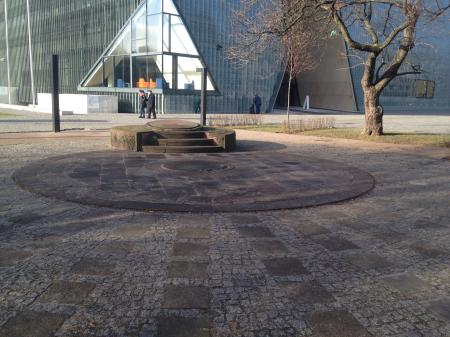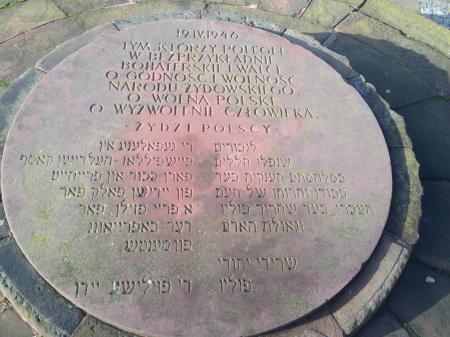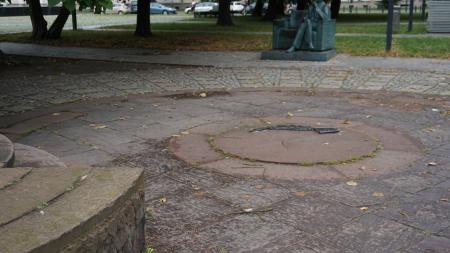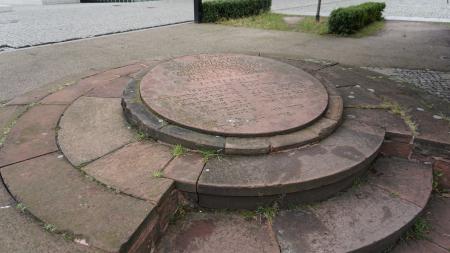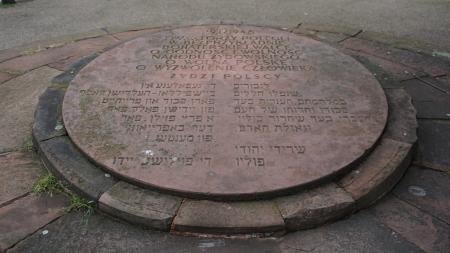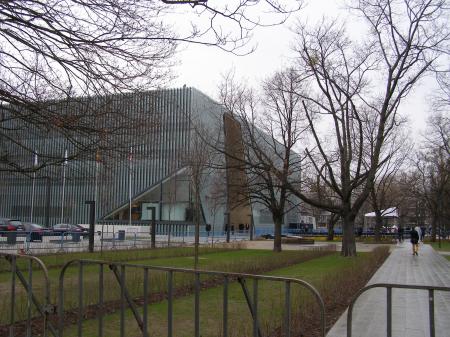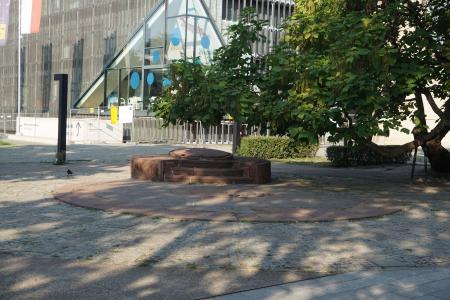Obj. ID: 49736
Modern Jewish Art First Monument to the Warsaw Ghetto Uprising in Warsaw, Poland, 1946

Memorial Name
First Ghetto Monument
Who is Commemorated?
Fighters of the Warsaw Ghetto Uprising
Description:
A circular paved area has a red sandstone disk in the center. Overlapping the paved circle is a smaller circle – raised by three steps – which leads to a bigger sandstone disk that is inscribed with memorial inscriptions in Polish, Yiddish, and Hebrew.
This disk is slightly tilted in the direction of the former (now gone) Ghetto gate, through which German tanks attempted to enter the Ghetto, and marks the site of the first armed clash of the Warsaw Ghetto Uprising on April 19, 1943.
Inscriptions
Polish
19.IV.1946
TYM KTORZY POLEGLI
W BEZPRZYKŁADNIE
BOHATERSKIEJ WALCE
O GODNOŠČ I WOLNOŠČ
NARODU ŽYDOWSKIEGO
O WOLNA POLSKE
O WYZWOLENIE CZŁOWIEKA
ŽYDZI POLSCY
Translation: To the memory of those who died in an unparalleled and heroic struggle for the dignity and freedom of the Jewish nation, for free Poland, and for the liberation of mankind - Jews of Poland.
Hebrew
לגבורים
שנפלו חללים
במלחמתם הענקית בעד
כבודו והרוחו של העם
העברי בעד שחרור פולין
.וגאולת האדם
שרידי יהודי
פולין
Translation: To the heroes who fell as martyrs in their war for the honor and spirit of the Hebrew people, for the liberation of Poland and for the redemption of man. / The Remnants of Polish Jews
Yiddish
די געפאלענע אין
ביישפיללאו - העלדישן קאמף
פארן כבוד און פרייהייט
פון יידישן פאלק פאר
א פריי פולין. פאר
דער באפרייאונג
פון מענטש
די פוילישע יידן
Translation: Those who fell in the heroic struggle for the honor and freedom of the Jewish people, for the liberation of the people, for free Poland. For freedom pf the people / Polish Jews
Commissioned by
Jewish survivors in Poland
sub-set tree:
The first World War II-related memorial was built by architect L. M. Suzin in Warsaw. It was installed in April 1946 to mark the third anniversary of the Ghetto Uprising. Subsequent urban changes have removed the specific points of reference in relationship to which the monument was situated; most notably the Ghetto gate which no longer exists. Thus, the original significance has been lost. In the 1990s Kostanty Gebart wrote that “contemporary sources, probably on the basis of the monument's circular form, erroneously interpret it as being a sewer entrance, like those used by fighters to leave the Ghetto.” [Gebert, 123]
Shortly after the monument's unveiling in 1946, Suzin also designed a memorial plaque for the wall of the Umschlagplatz (loading dock), the railroad platform from which some 350,000 of the Ghetto's Jews were deported to Treblinka. In 1948 he created the base for the nearby and much larger Warsaw Ghetto Uprising monument by Nathan Rapoport, inaugurated in 1948.
Gebert, Kontanty, “The Dialectics of Memory in Poland: Holocaust Memorials in Warsaw,” in James E. Young, The Art of Memory: Holocaust Memorials in History (New York: Jewish Museum, 1994), 121-129., 121-129.


